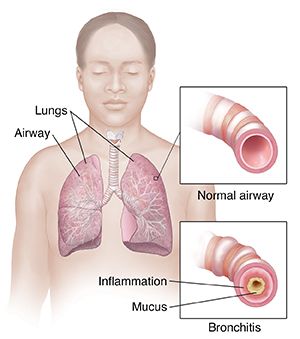What Is Acute Bronchitis?
Acute bronchitis is when the airways in your lungs (bronchial tubes) become red and swollen (inflamed). It's often caused by a viral infection, but bacteria or an allergen can also cause it. Symptoms include a cough that produces yellow or greenish mucus and can last for days or weeks.

Lungs with bronchitis
Bronchitis often goes along with a cold or the flu virus. The airways become inflamed. There's a deep hacking cough from the extra mucus. Other symptoms may include:
-
Wheezing.
-
Chest discomfort.
-
Shortness of breath.
-
Mild fever.
A second infection may then start because of bacteria. Airways irritated by allergens or smoke may be more likely to get infected.
Making a diagnosis
Your health care provider will do a physical exam, ask about your health history, and do certain tests to help them make the diagnosis.
Health history
Your provider will ask you about past illnesses and your current symptoms. You'll also be asked if you smoke, have any allergies, and take any prescription medicines or over-the-counter medicines, vitamins, herbs, and supplements.
The exam
Your provider will listen to your chest for signs of congestion. They may also check your ears, nose, and throat.
Possible tests
-
A sputum test for bacteria. This requires a sample of mucus from your lungs.
-
A nose or throat swab. This test is to see if you have a bacterial or viral infection.
-
A chest X-ray. This is done if your health care provider thinks you have pneumonia.
You may also have other tests to check for allergies, asthma, or COPD (chronic obstructive pulmonary disease). Your provider may tell you to see a specialist for more lung function testing.
Treating a cough
The main treatment for bronchitis is easing symptoms. Staying away from smoke, allergens, and other things that set off coughing can often help. If the infection is bacterial, you may need to take antibiotics. While you're sick, it's important to get plenty of sleep. To ease symptoms:
-
Don’t smoke. Also, stay away from secondhand smoke.
-
Use a humidifier. Or try breathing in steam from a hot shower. This may help loosen mucus.
-
Drink a lot of water and 100% juice. These can soothe the throat and may help thin mucus.
-
Sit up or use extra pillows when in bed. This helps to reduce coughing and congestion.
-
Ask your provider about using medicine. Choices may include over-the-counter products for coughs, pain, fever, and congestion.
Antibiotics
Most cases of bronchitis are caused by a virus, not bacteria. These cases don’t need antibiotics to treat them, even if your mucus is thick and green or yellow. Antibiotics don’t help your body get rid of viral illnesses, including acute viral bronchitis. Taking antibiotics when they aren't needed increases the risk that they won't work later when you do have a bacterial infection. (This means that it's become antibiotic-resistant.) Antibiotics can also cause severe cases of diarrhea that need treated with other antibiotics. It's important that you accept your health care provider's advice to not use antibiotics.
Your provider may prescribe antibiotics if the infection is caused by bacteria. If they're prescribed:
-
Take all of the medicine. Take the medicine until it's used up, even if your symptoms have improved. If you don’t, the bronchitis may come back.
-
Take the medicine as directed. For instance, some medicines should be taken with food.
-
Ask about side effects. Ask your provider or pharmacist what side effects are common, and what to do about them.
Follow-up care
You should follow up with your health care provider as directed.
Prevention
-
Stay away from tobacco smoke. If you smoke, quit and stay away from secondhand smoke. Ask friends and family not to smoke around you, in your home, or in the car.
-
Get checked for allergies.
-
Ask your health care provider about getting a yearly flu shot. Also ask about pneumococcal (pneumonia) shots.
-
Wash your hands often. This helps reduce the chance of picking up viruses that cause colds and flu. Use soap and warm water. Rub your hands together for at least 20 seconds. Wash between your fingers and under your fingernails. Use a towel to dry your hands.
When to call your doctor
Contact your health care provider right away if:
-
Symptoms get worse, or you have new symptoms.
-
Breathing problems get worse.
-
Symptoms don’t get better within a week or within a few days of taking antibiotics.
Call 911
Call 911 if you:
-
Are wheezing.
-
Feel lightheaded or dizzy.
-
Can't talk.
-
Have skin, lips, or nails that look blue, gray, or pale.